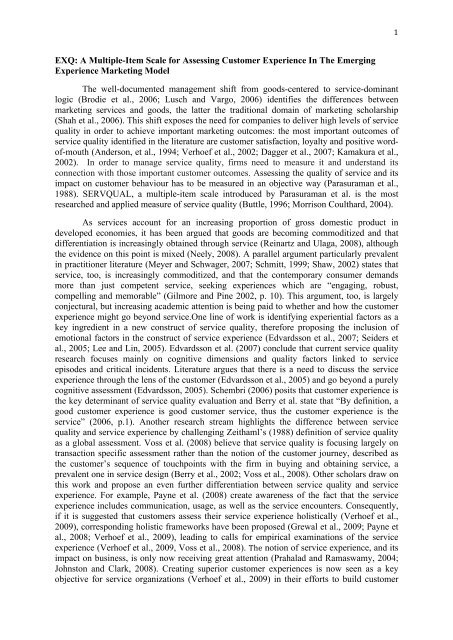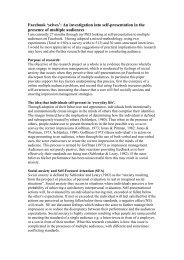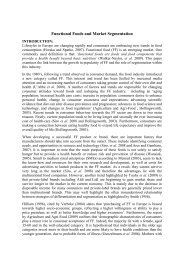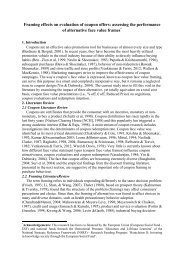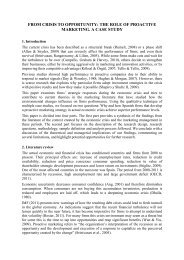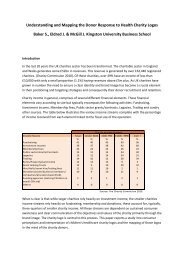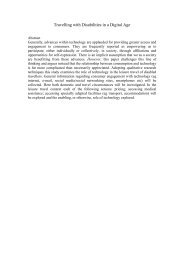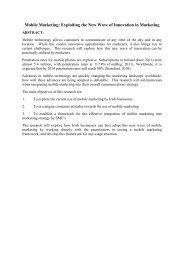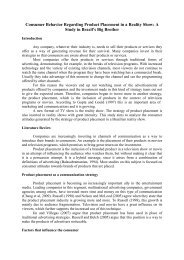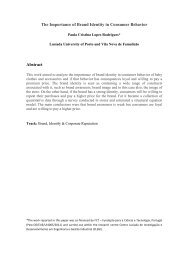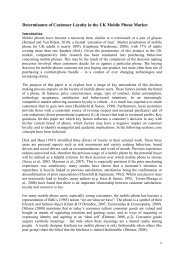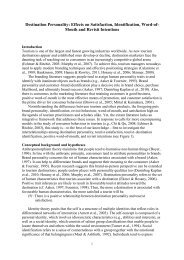EXQ: A Multiple-Item Scale for Assessing Customer Experience In ...
EXQ: A Multiple-Item Scale for Assessing Customer Experience In ...
EXQ: A Multiple-Item Scale for Assessing Customer Experience In ...
You also want an ePaper? Increase the reach of your titles
YUMPU automatically turns print PDFs into web optimized ePapers that Google loves.
<br />
<strong>EXQ</strong>: A <strong>Multiple</strong>-<strong>Item</strong> <strong>Scale</strong> <strong>for</strong> <strong>Assessing</strong> <strong>Customer</strong> <strong>Experience</strong> <strong>In</strong> The Emerging<br />
<strong>Experience</strong> Marketing Model <br />
The well-documented management shift from goods-centered to service-dominant<br />
logic (Brodie et al., 2006; Lusch and Vargo, 2006) identifies the differences between<br />
marketing services and goods, the latter the traditional domain of marketing scholarship<br />
(Shah et al., 2006). This shift exposes the need <strong>for</strong> companies to deliver high levels of service<br />
quality in order to achieve important marketing outcomes: the most important outcomes of<br />
service quality identified in the literature are customer satisfaction, loyalty and positive wordof-mouth<br />
(Anderson, et al., 1994; Verhoef et al., 2002; Dagger et al., 2007; Kamakura et al.,<br />
2002). <strong>In</strong> order to manage service quality, firms need to measure it and understand its<br />
connection with those important customer outcomes. <strong>Assessing</strong> the quality of service and its<br />
impact on customer behaviour has to be measured in an objective way (Parasuraman et al.,<br />
1988). SERVQUAL, a multiple-item scale introduced by Parasuraman et al. is the most<br />
researched and applied measure of service quality (Buttle, 1996; Morrison Coulthard, 2004).<br />
As services account <strong>for</strong> an increasing proportion of gross domestic product in<br />
developed economies, it has been argued that goods are becoming commoditized and that<br />
differentiation is increasingly obtained through service (Reinartz and Ulaga, 2008), although<br />
the evidence on this point is mixed (Neely, 2008). A parallel argument particularly prevalent<br />
in practitioner literature (Meyer and Schwager, 2007; Schmitt, 1999; Shaw, 2002) states that<br />
service, too, is increasingly commoditized, and that the contemporary consumer demands<br />
more than just competent service, seeking experiences which are “engaging, robust,<br />
compelling and memorable” (Gilmore and Pine 2002, p. 10). This argument, too, is largely<br />
conjectural, but increasing academic attention is being paid to whether and how the customer<br />
experience might go beyond service.One line of work is identifying experiential factors as a<br />
key ingredient in a new construct of service quality, there<strong>for</strong>e proposing the inclusion of<br />
emotional factors in the construct of service experience (Edvardsson et al., 2007; Seiders et<br />
al., 2005; Lee and Lin, 2005). Edvardsson et al. (2007) conclude that current service quality<br />
research focuses mainly on cognitive dimensions and quality factors linked to service<br />
episodes and critical incidents. Literature argues that there is a need to discuss the service<br />
experience through the lens of the customer (Edvardsson et al., 2005) and go beyond a purely<br />
cognitive assessment (Edvardsson, 2005). Schembri (2006) posits that customer experience is<br />
the key determinant of service quality evaluation and Berry et al. state that “By definition, a<br />
good customer experience is good customer service, thus the customer experience is the<br />
service” (2006, p.1). Another research stream highlights the difference between service<br />
quality and service experience by challenging Zeithaml’s (1988) definition of service quality<br />
as a global assessment. Voss et al. (2008) believe that service quality is focusing largely on<br />
transaction specific assessment rather than the notion of the customer journey, described as<br />
the customer’s sequence of touchpoints with the firm in buying and obtaining service, a<br />
prevalent one in service design (Berry et al., 2002; Voss et al., 2008). Other scholars draw on<br />
this work and propose an even further differentiation between service quality and service<br />
experience. For example, Payne et al. (2008) create awareness of the fact that the service<br />
experience includes communication, usage, as well as the service encounters. Consequently,<br />
if it is suggested that customers assess their service experience holistically (Verhoef et al.,<br />
2009), corresponding holistic frameworks have been proposed (Grewal et al., 2009; Payne et<br />
al., 2008; Verhoef et al., 2009), leading to calls <strong>for</strong> empirical examinations of the service<br />
experience (Verhoef et al., 2009, Voss et al., 2008). The notion of service experience, and its<br />
impact on business, is only now receiving great attention (Prahalad and Ramaswamy, 2004;<br />
Johnston and Clark, 2008). Creating superior customer experiences is now seen as a key<br />
objective <strong>for</strong> service organizations (Verhoef et al., 2009) in their ef<strong>for</strong>ts to build customer<br />
1
<br />
loyalty (Badgett, Boyce and Kleinberger, 2007). A corresponding scale needs to be<br />
developed to evaluate the service experience from the customer’s point of view (Verhoef et<br />
al., 2009). To develop the new measure, it is recognized that “scale [development] must go<br />
hand-in-hand with conceptual development of the construct [service experience] itself”<br />
(Brakus et al., 2009, p. 52). There<strong>for</strong>e the measure should be based on a broader and more<br />
comprehensive conceptualization (Verhoef et al., 2009) that links the service experience to<br />
purchasing behaviour. This conceptual model of service experience aims to refine existing<br />
conceptual models <strong>for</strong> customer experience which have been proposed both in conceptual<br />
studies (Verhoef et al., 2009) and in studies which elicit the supplier’s perception rather than<br />
the customer’s (Payne et al., 2008; Voss et al., 2008). We recapitulate that service experience<br />
is an evolving concept. The emerging service experience construct is far broader than the<br />
limited functional service encounter suggested by current measures. It includes pre and post<br />
service encounter experiences, addresses emotional as well as functional dimensions of<br />
quality and includes the customer’s social context. It includes an assessment of value-in-use,<br />
is <strong>for</strong>med over multiple channels and varies with context (Lemke et al., 2010). Building on<br />
this and the previously cited definitions, and the context of our research, we define service<br />
experience as the customer’s cognitive and affective assessment of all direct and indirect<br />
encounters with the firm relating to their behavioural loyalty as defined by Oliver (1997).<br />
This article describes the development and validation of a multiple-item scale <strong>for</strong><br />
service experience (<strong>EXQ</strong>) and provides (a) a sought after conceptualization that captures the<br />
domains of the construct, (b) a measure from the customers’ point of view, (c) a validation of<br />
the psychometric properties of the scale and (d) it demonstrates the effects of our empirically<br />
derived conceptualization with respect to important customer outcomes: satisfaction, loyalty<br />
and word-of-mouth. Drawing from the literature, we conduct a qualitative study that<br />
generates attributes of service experience. The proceeding section describes the purification<br />
and validation of a scale and its psychometric properties. The article then validates the scale<br />
to generate an empirically founded definition of service experience (<strong>EXQ</strong>). The penultimate<br />
section explores the nature and degree of <strong>EXQ</strong>’s impact on customers’ satisfaction, loyalty<br />
and word-of-mouth. The final section discusses the findings of the study and its managerial<br />
implications<br />
Definition and Domain of <strong>EXQ</strong><br />
To incorporate the wide range of possible assessment of service experience criteria arising<br />
from the literature, we use a framework based on the means-end-chain approach<br />
(Parasuraman et al., 2005). Our study presents a validated multi-item scale based on the<br />
underlying construct of service experience that extends previous research on service<br />
experience and service quality measures. The measure is called the service experience scale:<br />
‘<strong>EXQ</strong>’. The research determines its dimensions by analysing that which customers describe<br />
as the triggers of their purchasing and re-purchasing behaviour. The methodology follows<br />
Churchill’s (1979) scale development paradigm. As suggested by the literature, and other<br />
scale-developing studies (Walsh and Beatty, 2007), the scale will be developed in four stages:<br />
scale generation, initial purification, refinement and validation (<strong>for</strong> a more detailed<br />
description of the procedure see Appendix A).<br />
Stage 1 articulates the meaning and domain of service experience based on insights<br />
from the literature and a comprehensive qualitative study. It results in a preliminary scale<br />
containing 37 items that represent five dimensions. Stage 2 describes the administration of<br />
the scale to a representative sample of repeat mortgage purchasers of a UK bank from 175<br />
completed questionnaires. Using exploratory factor analysis, the scale is purified to 19 items<br />
2
<br />
that represent four service experience dimensions. <strong>In</strong> Stage 3 we conduct confirmatory factor<br />
analysis (CFA) to validate the purified scale based on 218 collected questionnaires from a<br />
representative sample, which confirms the scale’s reliability and validity. Stage 4 introduces<br />
the final scale and the conceptual framework of service experience. The study assesses the<br />
relative importance of the service experience in influencing consumers’ overall satisfaction<br />
perceptions, loyalty and word-of-mouth intentions.<br />
<strong>Scale</strong> Development and Findings<br />
Stage 1: The Qualitative Study<br />
Stage 1 explores the perceptual attributes of experience through in-depth interviews<br />
using soft laddering (Grunert & Grunert 1995), a technique where respondents are restricted<br />
as little as possible in their natural flow of speech. This is an accepted method <strong>for</strong> assessing<br />
consumers’ cognitive structures and underlying purchasing (Reynolds & Gutman 1988). We<br />
achieved data saturation (Glaser & Strauss 1967) after conducting individual in-depth<br />
interviews with 30 mortgage customers from the UK over a four week period: each interview<br />
lasted between 30 to 60 minutes. We used a random sample of the Bank’s customers who had<br />
purchased one or more mortgages in the previous six months, split between first time buyers<br />
and repeat buyers. The interviews were transcribed, coded and analysed following a grounded<br />
approach (Strauss & Corbin 1998); 58 customer experience items were generated. To<br />
maximize the content and face validity of the items generated, a panel of expert judges<br />
reviewed the retained item pool (Dagger et al. 2007) and per<strong>for</strong>med three tasks: (1) assessed<br />
the similarity of items, the clarity of phrasing and the terminology used in the scale, (2) rated<br />
each item with respect to its relevance to the item description and (3) suggested dimensions<br />
and sub-dimensions that evolved from the research model and items. Five dimensions<br />
representing 37 items resulted from this stage.<br />
Stage 2: <strong>Scale</strong> Purification through Exploratory Factor Analysis (EFA)<br />
The scale was purified through EFA. Data were collected through a random sample of<br />
the Bank’s customers who had purchased more than one mortgage from the bank and the<br />
most recent mortgage within the previous six months. The samples are analogous (see<br />
Appendix B). Exploratory factor analysis summarises the data into a minimum number of<br />
factors <strong>for</strong> prediction purposes. The resulting purified scale comprises four primary<br />
dimensions with 19 corresponding items, which, in conjunction with the expert panel, were<br />
labelled as follows to make the acronym POMP (see Appendix C):<br />
1. Product experience – <strong>Customer</strong>s’ perception of having choices and the ability to compare<br />
offers. Choice dynamics are established as a critical factor in modeling consumer behaviour<br />
(McAlister and Srivastava 1991) and as an antecedent of loyalty (Srinivasan et al. 1998).<br />
2. Outcome focus - is associated with reducing customers’ transaction costs, such as seeking<br />
out and qualifying new providers. This dimension reflects the importance of goal-oriented<br />
experiences in consumer behaviour (Huffman and Houston 1993), suggested by statements<br />
such as: “We just wanted to get the mortgage as soon as possible.”<br />
3. Moments-of-truth – This dimension is characterised by that which is commonly knows as<br />
moments-of-truth, emphasising the importance of service recovery (Tax & Brown 1998) and<br />
flexibility (Liljander & Strandvik 1997) when faced with un<strong>for</strong>eseen complications.<br />
4. Peace-of-mind –This dimension includes statements associated strongly with the emotional<br />
aspects of service and is based upon the perceived expertise of the service provider and the<br />
guidance provided throughout the process (Bendapudi & Berry 1997).<br />
3
<br />
The findings indicate that service experience is a holistic construct (Verhoef et al.,<br />
2009), including determinants such as social interactions (Bagozzi, 2000), price (Baker et al.,<br />
2002), brand (Brodie et al., 2006) and channels. The validity of the findings is scrutinized in<br />
the subsequent quantitative data analysis (as outlined in Appendix A).<br />
Stage 3 & Stage 4: Reliability and Validity Assessment through Confirmatory Factor<br />
Analysis<br />
To per<strong>for</strong>m the analysis, further data were collected: 218 qualified responses from a<br />
random sample of Bank customers. <strong>Scale</strong>s from existing scale development studies were<br />
examined to determine the best choice <strong>for</strong> measuring the exogenous variables: customer<br />
satisfaction, loyalty and word-of-mouth intentions. The outcome is a scale measure of<br />
customer experience (<strong>EXQ</strong>) illustrated in Figure 1. A full definition of each of the attributes<br />
identified in the left hand side boxes is provided in Appendix C and Appendix D.<br />
Figure 1 Conceptual Model <strong>Customer</strong> <strong>Experience</strong> Quality <strong>EXQ</strong><br />
The scale developed is a valid and reliable in explaining the relationship between<br />
customer experience and the selected outcomes (see Appendix E). The squared multiple<br />
correlations are as follows: <strong>for</strong> loyalty it is 86%, <strong>for</strong> customer satisfaction it is 63% and <strong>for</strong><br />
positive word-of-mouth intention it is 94%. We compare the explanatory power of <strong>EXQ</strong> with<br />
customer satisfaction and our findings (Table 1) demonstrate stronger relationships between<br />
service experience and loyalty, as defined in this study, than between customer satisfaction<br />
and loyalty. Compared with the relationship between customer satisfaction and word-ofmouth,<br />
we also establish a more direct link between service experience and word-of-mouth.<br />
There<strong>for</strong>e, whilst there is a body of literature offering customer satisfaction as a mediator<br />
between service quality and loyalty and word-of-mouth (Seiders et al. 2005), service<br />
experience could be an even better predictor of loyalty and word-of-mouth.<br />
<strong>Customer</strong> Satisfaction Loyalty Word-of-Mouth<br />
<strong>Experience</strong> Quality 0.63 0.86 0.94<br />
<strong>Customer</strong> Satisfaction - 0.65 0.87<br />
Table 1 Explanatory Power of <strong>EXQ</strong> versus <strong>Customer</strong> Satisfaction <br />
<br />
4
<br />
Our study discovers that the four POMP dimensions of customer experience explain<br />
most of the Bank’s loyalty, word-of-mouth and customer satisfaction. The findings indicate<br />
that customers evaluate the customer experience at an overall level, a dimensional level and<br />
at attribute level and that each level drives perception on the level above.<br />
Discussion<br />
The findings suggest that customers base their perceptions of service experience on<br />
four dimensions: product experience, outcome focus, moments-of-truth and peace-of-mind<br />
(POMP). The findings improve our understanding of how customers evaluate their service<br />
experience by linking their evaluation to important marketing outcomes, namely customer<br />
satisfaction, loyalty and word-of-mouth intentions. <strong>EXQ</strong>, and its empirically derived<br />
construct of service experience, offer a stimulus and foundation to advance service<br />
marketing, particularly service quality and service experience research, by delivering a<br />
measure capable of capturing all facets of the construct of the service experience (Verhoef et<br />
al., 2009). Moreover, this scale measures the impact of the distinctive drivers of the service<br />
experience on each of the components of the service experience (Verhoef et al., 2009). The<br />
findings support previous conceptual papers that suggest the service experience is broadly<br />
based (Shembri, 2006; Berry et al., 2006), yet not as broad as suggested by some (Verhoef et<br />
al., 2009; Gentile et al., 2007; Meyer and Schwager, 2007). The implication of our findings is<br />
that scholars risk overcompensating <strong>for</strong> service quality’s limitations by defining service<br />
experience too widely.<br />
The assessment of the overall service experience, as measured by the scale <strong>EXQ</strong>, reflects the<br />
evaluation of customers who recently repurchased a mortgage with a financial service<br />
provider in correlation to important outcome variables. The strong association between<br />
service experience quality and behavioural intentions is noteworthy because satisfaction is<br />
generally viewed as more closely aligned with behavioural intentions (Cronin and Taylor,<br />
1992). Traditionally, customer satisfaction is modeled as a mediator between service quality<br />
and behavioural intention (Cronin and Taylor, 1992). Research points out that service quality<br />
also has a mediating role between service attributes and behavioural intentions, stating that its<br />
attributes are more strongly related to the overall service quality than to behavioural<br />
intentions (Dagger et al., 2007). Our findings demonstrate significantly stronger relationships<br />
between service experience and loyalty, as defined in this study, than between customer<br />
satisfaction and loyalty. Compared with the relationship between customer satisfaction and<br />
word-of-mouth, we also established a more direct link between service experience and wordof-mouth.<br />
There<strong>for</strong>e, while there is a body of literature offering customer satisfaction as a<br />
mediator between service quality and loyalty and word-of-mouth (Seiders et al., 2005), our<br />
research advocates that service experience could be an even better predictor of loyalty and<br />
word-of-mouth.<br />
Managerial Implications<br />
<strong>EXQ</strong> provides a measure to help managers benchmark and track per<strong>for</strong>mance over time.<br />
More importantly, it illustrates a detailed structure whereby managers can determine which<br />
attributes of the customers’ service experience are most strongly associated with the<br />
marketing outcomes organizations are trying to achieve. This is a positive contribution to<br />
making Marketing more accountable as managers can relate investments in service<br />
experience more directly with the outcomes closest to income such as loyalty and word-ofmouth.<br />
There<strong>for</strong>e managers should consider service experience as an important strategic<br />
objective.<br />
5
<br />
Appendices<br />
Appendix A: <strong>Scale</strong> Development Process to Measure <strong>Customer</strong> <strong>Experience</strong> Quality<br />
6
<br />
Appendix B: Profile of the Two Samples<br />
Variable Exploratory Study Confirmatory Study<br />
Age in Years Percentage Percentage<br />
18-25 2.20 3.10<br />
26-35 36.00 34.40<br />
36-45 29.30 28.10<br />
46-55 20.90 20.00<br />
56-64 11.60 10.60<br />
65 + NA ª 3.80<br />
Sex<br />
Male 64.00 60.20<br />
Female 46.00 39.80<br />
Level of Education<br />
High School or less 31.90 36.00<br />
Some College 47.50 50.30<br />
College Graduate 12.80 12.40<br />
Graduate School 7.8 1.3<br />
7
<br />
Appendix C: Dimensions <strong>Customer</strong> <strong>Experience</strong> Quality (<strong>EXQ</strong>)<br />
PRODUCT<br />
EXPERIENCE<br />
(PRO)<br />
PRO1 Freedom of<br />
Choice<br />
PRO2 Comparison<br />
Necessity<br />
PRO3 Cross-<br />
product<br />
Comparison<br />
PRO4 Account<br />
Management<br />
Dimensions Service <strong>Experience</strong> <strong>EXQ</strong> (POMP)<br />
OUTCOME FOCUS<br />
(OUT)<br />
OUT1 <strong>In</strong>ertia<br />
OUT2 Result Focus<br />
OUT3 Past<br />
<strong>Experience</strong><br />
<strong>In</strong>fluence<br />
OUT4 Common<br />
Grounding<br />
MOMENTS-OF-<br />
TRUTH (MOM)<br />
MOM1 Flexibility<br />
MOM2 Pro-activity<br />
MOM3 Risk<br />
Perception<br />
MOM4<br />
<strong>In</strong>terpersonal Skills<br />
MOM5 Service<br />
Recovery<br />
PEACE-OF-MIND<br />
(PEA)<br />
PEA1 Expertise –<br />
Peace of Mind<br />
PEA2 Process Ease<br />
PEA3 Relationship<br />
versus Transaction<br />
PEA4 Convenience<br />
Retention<br />
PEA5 Familiarity<br />
PEA6 <strong>In</strong>dependent<br />
Advice<br />
8
<br />
Appendix D: Measures of Study Constructs<br />
<strong>EXQ</strong><br />
Respondents rated their customer experience on each scale item using a 7-point scale (1 =<br />
strongly disagree, 7 = strongly agree) with a Do not know/Not applicable option as additional<br />
option next to the scale. The items below are grouped by dimensions <strong>for</strong> expositional<br />
convenience; they appeared in random order on the survey. The symbols preceding the items<br />
correspond to the variables named in Figure 3.<br />
Peace of mind<br />
PEA1 I am confident in their expertise; they know what they are doing.<br />
PEA2 The whole process was so easy, they took care of everything.<br />
PEA3 It is not just about the now; this company will look after me <strong>for</strong> a long time.<br />
PEA4 I am already a customer; they know me and take good care of me, so why should I go<br />
somewhere else?<br />
PEA5 I have dealt with them be<strong>for</strong>e so getting a mortgage was really easy.<br />
PEA6 I choose them because they give independent advice.<br />
Moments-of-Truth<br />
MOM1 It was important that the company was flexible in dealing with me and looking out<br />
<strong>for</strong> my needs.<br />
MOM2 It is important that they keep me up-to-date and in<strong>for</strong>m me about new options.<br />
MOM3 I want to deal with a safe company, because a mortgage is a lot of money.<br />
MOM4 It is important that the people I am dealing with are good people; they listen, are<br />
polite and make me feel com<strong>for</strong>table.<br />
MOM5 The way they deal(t) with me when things go(went) wrong will decide if I stay with<br />
them.<br />
Outcome Focus<br />
OUT1 Yes, there are other companies, but I would rather stay with mine; it makes the<br />
process much easier.<br />
OUT2 It was more important to get the mortgage than to shop around <strong>for</strong> a better rate.<br />
OUT3 I stay with my company because I am not confident about using an alternative<br />
provider.<br />
OUT4 It was important that the advisor had a mortgage too; he/she knew what I was going<br />
through.<br />
9
<br />
Product <strong>Experience</strong><br />
PRO1 I want to choose between different options to make certain I get the best offer.<br />
PRO2 It is important to me to receive mortgage offers from different companies.<br />
PRO3 Unless I can compare different options, I will not know which one is the best <strong>for</strong> me.<br />
PRO4 It would be great if I could deal with one designated contact through the entire<br />
process of getting my mortgage.<br />
<strong>Customer</strong> Satisfaction<br />
The satisfaction measures consisted of three rating items; respondents indicated their<br />
satisfaction on each scale item using a 7-point scale (1 = strongly disagree, 7 = strongly<br />
agree) with a Do not know/Not applicable option next to the scale.<br />
SAT1 I am satisfied with the service my mortgage service provider provides to me.<br />
SAT2 I am satisfied with my overall experience with my mortgage service provider.<br />
SAT3 As a whole, I am not satisfied with my mortgage service provider (reversed score<br />
item).<br />
Loyalty<br />
The loyalty measures consisted of three items using a 7-point scale (1 = strongly disagree, 7 =<br />
strongly agree) with a Do not know/Not applicable option at the center of the scale.<br />
LOY1 I am a loyal customer of my mortgage service provider.<br />
LOY2 I have developed a good relationship with my mortgage service provider.<br />
LOY3 I am loyal to my mortgage service provider.<br />
Word-of-Mouth<br />
The word-of-mouth measures consisted of three items; respondents indicated their likelihood<br />
of engaging in each behaviour on each scale item using a 7-point scale (1 = strongly disagree,<br />
7 = strongly agree) with a Do not know/Not applicable option next to the scale.<br />
WOM1 I am likely to say good things about my mortgage service provider.<br />
WOM2 I would recommend my mortgage service provider to my friends and relatives.<br />
WOM3 If my friends were looking <strong>for</strong> a new company of this type, I would tell them to try<br />
my mortgage service provider.<br />
10
<br />
Appendix E: Measurement Reliability and Validity Analysis<br />
Measurement Model Construct Reliability Average Variance Extracted<br />
Satisfaction 0.70 0.77<br />
Loyalty 0.94 0.84<br />
Word-of-mouth 0.96 0.90<br />
<strong>EXQ</strong> dimensions<br />
Peace-of-mind 0.80 0.83<br />
Moments-of-truth 0.81 0.75<br />
Outcome focus 0.75 0.71<br />
Product experience 0.80 0,79<br />
Goodness-of-fit indices CMIN df CFI IFI RMSEA<br />
711 392 .91 .91 .05<br />
11
<br />
Dimension<br />
Composite Reliability<br />
Peace-of-Mind .69<br />
Moments-of-Truth .71<br />
Outcome Focus .61<br />
Product <strong>Experience</strong> .66<br />
<strong>Customer</strong> Satisfaction .70<br />
Loyalty .90<br />
Word-of-Mouth .95<br />
<strong>Item</strong> Construct Reliability Score<br />
PEA1 .833<br />
PEA2 .678<br />
PEA3 .631<br />
PEA4 .422<br />
PEA5 .548<br />
PEA6 .558<br />
MOM1 .669<br />
MOM2 .652<br />
MOM3 .568<br />
MOM4 .522<br />
MOM5 .484<br />
OUT1 .477<br />
OUT2 .518<br />
OUT3 .695<br />
OUT4 .455<br />
PRO1 .744<br />
PRO2 .744<br />
PRO3 .841<br />
PRO4 .500<br />
SAT1 .970<br />
SAT2 .970<br />
SAT3 -.670 (reversed score item)<br />
LOY1 .910<br />
LOY2 .910<br />
LOY3 .930<br />
WOM1 .940<br />
WOM2 .970<br />
WOM3 .940<br />
Standard Path Estimates 1<br />
<strong>Customer</strong> Satisfaction Loyalty Word-of-mouth<br />
Peace-of-mind .90 .72 .40<br />
Moments-of-truth .04 .13 .09<br />
Outcome focus .09 .20 .20<br />
Product experience .10 .09 .04<br />
<br />
1 t values were significant on the base of one-tailed test<br />
12
<br />
REFERENCES<br />
Abbott, L. (1955), Quality and Competition. New York: Columbia University Press.<br />
Ajzen, I. and M. Fishbein (1977), "Attitude-Behaviour Relations: a Theoretical Analysis and<br />
Review of Empirical Research," Psychological Bulletin, 84 (5), 888-918.<br />
Anderson, J. and D. Gerbing (1988) “Structural Equation Modeling in Practice: a Review and<br />
Recommended Two-Step Approach,” Psychological Bulletin, 103 (3), 411–23.<br />
Arnould, E. and L. Price (1993), “River Magic: Extraordinary <strong>Experience</strong> and the Extended<br />
Service Encounter,” Journal of Consumer Research, 20 (1), 24–45.<br />
Badget, M., M. Moyce and H. Kleinberger (2007), Turning Shopper into Advocates. IBM<br />
<strong>In</strong>stitute <strong>for</strong> Business Value.<br />
Bagozzi, R. and T. Heatherton (1994), "A General Approach to Representing Multifaceted<br />
Personality Constructs: Application to State Self-Esteem," Structural Equation Modeling, 1<br />
(1), 35-67.<br />
Bagozzi, R.and G. Foxall (1996), "Construct Validation of a Measure of Adaptive-<strong>In</strong>novative<br />
Cognitive Styles in Consumption," <strong>In</strong>ternational Journal of Research in Marketing, 13 (3),<br />
201-13.<br />
Bagozzi, R. (2000), “On the Concept of <strong>In</strong>tentional Social Action in Consumer Behaviour,”<br />
Journal of Consumer Research, 27 (3), 388–96.<br />
Baker, J., A. Parasuraman, D. Grewal and G. Voss (2002), “The <strong>In</strong>fluence of <strong>Multiple</strong> Store<br />
Environment Cues on Perceived Merchandise Value and Patronage <strong>In</strong>tentions,” Journal of<br />
Marketing, 66 (2), 120–41.<br />
Bendapudi, N. and L. Berry (1997), “<strong>Customer</strong>s’ motivations <strong>for</strong> maintaining relationships<br />
with service providers,” Journal of Retailing, (73), 15–37.<br />
Bendapudi, N. and R. Leone (2003), "Psychological Implications of <strong>Customer</strong> Participation<br />
on Co-production," Journal of Marketing, 67 (January), 14-28.<br />
Berry, L., L. Carbone and S. Haeckel (2002), “Managing the Total <strong>Customer</strong> <strong>Experience</strong>,”<br />
MIT Sloan Management Review, 43 (3), 85.<br />
Berry, L., E. Wall and L. Carbone (2006), “Service Clues and <strong>Customer</strong> Assessment of the<br />
Service <strong>Experience</strong>: Lessons from Marketing,” Academy of Management Perspectives, 20<br />
(2), 43-57.<br />
Bitner, M., W. Faranda, A. Hubbert and V. Zeithaml (1997), "<strong>Customer</strong> Contribution and<br />
Roles in Service Delivery," <strong>In</strong>ternational Journal of Service <strong>In</strong>dustry Management, 8 (3),<br />
193-205.<br />
Botschen, G., E. Thelen and R. Pieters (1999), “Using means-end structures <strong>for</strong> benefit<br />
segmentation: an application to services,” European Journal of Marketing, 33 (1), 38-58.<br />
Brady, M. and J. Cronin (2001), “Some New Thoughts on Conceptualizing Perceived Service<br />
Quality: a Hierarchical Approach,” Journal of Marketing, 65 (3), 34-49.<br />
13
<br />
Brakus, J., B. Schmitt and L. Zarantonello (2009), “Brand <strong>Experience</strong>: What is it? How is it<br />
Measured? Does it Affect Loyalty?” Journal of Marketing, 73 (3), 52-68.<br />
Brodie, R., M. Glynn and V. Little (2006), "The Service Brand and the Service-Dominant<br />
Logic: Missing Fundamental Premise or the Need <strong>for</strong> Stronger Theory?" Marketing Theory, 6<br />
(3), 363.<br />
Brodie, R. (2009), “From Goods to Service Branding: an <strong>In</strong>tegrative Perspective,”<br />
Marketing Theory, 9 (1), 107-11.<br />
Buzzell R. and Gale B., (1987), The PIMS Principles: Linking Strategy to Per<strong>for</strong>mance, Free<br />
Press, NY.<br />
Chandon, P., V. Morwitz and W. Reinartz (2005), "Do <strong>In</strong>tentions Really Predict Behaviour?<br />
Self-Generated Validity Effects in Survey Research," Journal of Marketing, 69 (2), 1.<br />
Churchill, G. (1979), “A Paradigm <strong>for</strong> Developing Better Measures of Marketing<br />
Constructs,” Journal of Marketing Research, 16 (1), 64–73.<br />
Clisbee, M. (2003), “Using N-Vivo <strong>for</strong> Literature Analysis: Strategies in Qualitative<br />
Research: Methodological Issues and Practices Using QSR NVivo and NUD*IST”, London:<br />
University of London.<br />
Cova, B. and S. Pace (2006), "Brand Community of Convenience Products: New Forms of<br />
<strong>Customer</strong> Empowerment – the Case ‘My Nutella the Community’," European Journal of<br />
Marketing, 40 (9/10), 1087-105.<br />
Crosby, L., K. Evans and D. Cowles (1990), “Relationship quality in services selling: An<br />
interpersonal influence perspective,” Journal of Marketing Research, (54), 68–81.<br />
Cronin, J. and S. Taylor (1992), “Measuring Service Quality: a Reexamination and<br />
Extension,” Journal of Marketing, 56 (3), 55-68.<br />
Dabholkar, P., D. Thorpe and J. Rentz (1996). “A Measure of Service Quality <strong>for</strong> Retail<br />
Stores: <strong>Scale</strong> Development and Validation,” Journal of the Academy of Marketing Science,<br />
24 (1), 3–16.<br />
Dagger, T., J. Sweeney and L. Johnson (2007), “A Hierarchical Model of Health Service<br />
Quality: <strong>Scale</strong> Development and <strong>In</strong>vestigation of an <strong>In</strong>tegrated Model,” Journal of Service<br />
Research, 10 (2), 123-42.<br />
Danermark, B., M. Ekstrom, L. Jakobsen and J. Karlsson (2002), Explaining Society: Critical<br />
Realism in the Social Sciences. London: Routledge.<br />
Darby, M. and E. Karni (1973), “Free Competition and the Optimal Amount of Fraud,”<br />
Journal of Law and Economics, 16 (1), 67-88.<br />
Day, R. (1980), “Research Perspectives on Consumer Complaining Behaviour”, in<br />
Theoretical Developments in Marketing, C. W. Lamb and P. M. Dunne, eds. Chicago, IL:<br />
American Marketing Association, 211-15.<br />
De Jong, A. and K. De Ruyter (2004), “Adaptive versus proactive behaviour in service<br />
recovery: the role of selfmanaging teams,” Decision Sciences, (35), 457–491.<br />
14
<br />
Diamantopoulos, A. and H. Winklhofer (2001), “<strong>In</strong>dex Construction with Formative<br />
<strong>In</strong>dicators: an Alternative to scale development,” Journal of Marketing Research, 38 (2),<br />
269-77.<br />
Diamantopoulos, A. (2005), “The C-OAR-SE Procedure <strong>for</strong> <strong>Scale</strong> Development in<br />
Marketing: a Comment,” <strong>In</strong>ternational Journal of Research in Marketing, 22 (1), 1–9.<br />
Di Gregorio, S. (2000), “Using Nvivo <strong>for</strong> your Literature Review”. Paper presented at the<br />
Meeting of the Strategies in Qualitative Research: l Issues and Results from the Analysis<br />
using QSR NVivo and NUD*IST”, London. Retrieved January 2nd, 2010, from<br />
http://www.sdgassociates.com/downloads/literature_review.pdf.<br />
Edvardsson, B. (2005), “Service Quality: Beyond Cognitive Assessment,” Managing Service<br />
Quality, 15 (2), 127-31.<br />
File, K. and R. Prince (1992), “Positive Word-of-Mouth: <strong>Customer</strong> Satisfaction and Buyer<br />
Behaviour,” <strong>In</strong>ternational Journal of Bank Marketing, 10 (1), 25-9.<br />
Flint, D. and J. Mentzer (2006), “Striving <strong>for</strong> <strong>In</strong>tegrated Value-Chain Management Given a<br />
Service-Dominant Logic <strong>for</strong> Marketing,” in The Service-Dominant Logic of Marketing, R.<br />
Lusch and S. Vargo, eds. Armonk, NY: M.E. Sharpe, 139–49.<br />
Fornell, C. and D. Larcker (1981), “Evaluating Structural Equation Models with<br />
Unobservable Variables and Measurement Error,” Journal of Marketing Research, 18 (1),<br />
39–50.<br />
Frow, P. and A. Payne (2007), "Towards the 'Perfect' <strong>Customer</strong> <strong>Experience</strong>," Journal of<br />
Brand Management, 15 (2), 89-101.<br />
Funder, D., R. Furr and C. Colvin (2000), “The riverside behavioural Q-sort: a tool <strong>for</strong> the<br />
description of social behaviour,” Journal of Personality, 68 (3), 451-89.<br />
Garver, M. and J. Mentzer (1999), "Logistics Research Methods: Employing Structural<br />
Equation Modeling to Test <strong>for</strong> Construct Validity," Journal of Business Logistics, 20 (1), 33-<br />
57.<br />
Gentile, C., N. Spiller and G. Noci (2007), “How to Sustain the <strong>Customer</strong> <strong>Experience</strong>: an<br />
Overview of <strong>Experience</strong> Components that Co-create Value with the <strong>Customer</strong>,” European<br />
Management Journal, 25 (5), 395–10.<br />
Geyskens, I., E. Jan-Benedict, M. Steenkamp, L. Scheer, and N. Kumar (1996), "The Effects<br />
of Trust and <strong>In</strong>terdependence on Relationship Commitment: A Trans-Atlantic Study,"<br />
<strong>In</strong>ternational Journal of Research in Marketing 13 (4), 303-317.<br />
Glaser, B. and A. Strauss (1967), The Discovery of Grounded Theory: Strategies <strong>for</strong><br />
Qualitative Research. Chicago: Aldine Publishing Company.<br />
Gronroos, C. (1997), "Value-Driven Relational Marketing: From Products to Resources and<br />
Competencies," Journal of Marketing Management, 13 (5), 407-419.<br />
Grunert, K. and S. Grunert (1995), “Measuring subjective meaning structures by the<br />
laddering method: theoretical considerations and methodological problems”, <strong>In</strong>ternational<br />
Journal of Research in Marketing, 12 (3), 209-25.<br />
15
<br />
Haeckel, S., L. Carbone and L. Berry (2003), "How to Lead the <strong>Customer</strong> <strong>Experience</strong>,"<br />
Marketing Management, 12 (1), 18.<br />
Hair, J., R. Anderson, R. Tatham and W. Black (1998), Multivariate Data Analysis. Upper<br />
Saddle River, NJ: Prentice Hall <strong>In</strong>ternational.<br />
Hirschman, E. and M. Holbrook (1982), “Hedonic Consumption: Emerging Concepts,<br />
Methods and Propositions,” Journal of Marketing, 46 (3), 92–101.<br />
Holbrook, M. (2006), “Book Reviews – the consumption experience,” Journal of<br />
Macromarketing, 26 (2), 259-66.<br />
Howard, J. and J. Sheth (1969), The Theory of Buyer Behaviour. New York: John Wiley.<br />
Hoyle, R. and A. Panter (1995), “Writing About Structural Equation Models,” in Structural<br />
Equation Modelling, R. Hoyle, ed. Thousand Oaks, CA: Sage Publications, 158-176.<br />
Huffman, C. and M.J. Houston (1993), ”Goal-oriented experiences and the development of<br />
knowledge,” Journal of Consumer Research, 20 (2), 190–207.<br />
Jarvis, C., S. MacKenzie and P. Podsakoff (2003), “A Critical Review of Construct <strong>In</strong>dicators<br />
and Measurement Model Misspecification in Marketing and Consumer Research,” Journal of<br />
Consumer Research, 30 (2), 199-18.<br />
Johnston, R. (1997), “Identifying the critical determinants of service quality in retail banking:<br />
importance and effect,” <strong>In</strong>ternational Journal of Bank Marketing, 15 (4), 111-16.<br />
Johnston, R. and G. Clark (2008), Service Operations Management, 3rd ed. London:<br />
Financial Times/Prentice Hall.<br />
Keaveney, S. (1995), "<strong>Customer</strong> Switching Behaviour in Service <strong>In</strong>dustries: an Exploratory<br />
Study," Journal of Marketing, 59 (2), 71.<br />
Keynes, J. (1936), The General Theory of Employment, <strong>In</strong>terest and Money. Cambridge:<br />
Macmillan Cambridge University Press.<br />
Klaus, Ph. and S. Maklan (2007), “The Role of Brands in a Service Dominated World”,<br />
Journal of Brand Management, 15 (22), 115-22.<br />
Kozinets, R. (2002), “The Field Behind the Screen: Using Netnography <strong>for</strong> Marketing<br />
Research in Online Communities,” Journal of Marketing Research, 39 (1), 61-72.<br />
LaSalle, D. and T. Britton (2003), Priceless: Turning Ordinary Products into Extraordinary<br />
<strong>Experience</strong>s. Boston: Harvard Business School Press.<br />
Liljander, V. and T. Strandvik (1993), “Estimating zones of tolerance in perceived service<br />
quality and perceived service value,” <strong>In</strong>ternational Journal of Service <strong>In</strong>dustry Management,<br />
4 (2), 6-28.<br />
Liljander, V. and T. Strandvik (1997), “Emotions in Service Satisfaction,” <strong>In</strong>ternational<br />
Journal of Service <strong>In</strong>dustry Management, 8 (2), 148.<br />
Lutz, R.J. (1975), “Changing brand attitudes through modification of cognitive structure,”<br />
Journal of Consumer Research,1 (March), 49-59.<br />
16
<br />
McAlister, L. and R.K.. Srivastava (1991), “<strong>In</strong>corporating choice dynamics in models of<br />
consumer behaviour,” Marketing Letters, 2 (3), 241–52.<br />
Mascarenhas, O., R. Kesavan and M. Bernacchi (2006), "Lasting <strong>Customer</strong> Loyalty: a Total<br />
<strong>Customer</strong> <strong>Experience</strong> Approach," Journal of Consumer Marketing, 23 (7), 397.<br />
Maxham, J. and R. Netemeyer (2002), “A Longitudinal Study of Complaining <strong>Customer</strong>s’<br />
Evaluations of <strong>Multiple</strong> Service Failures and Recovery Ef<strong>for</strong>ts,” Journal of Marketing, 66<br />
(4), 57–72.<br />
Meyer, C. and A. Schwager (2007), “Understanding <strong>Customer</strong> <strong>Experience</strong>,” Harvard<br />
Business Review, 85 (2), 117-26.<br />
Moore, G. and I. Benbasat (1999), “Development of an <strong>In</strong>strument to Measure the<br />
Perceptions of Adopting an <strong>In</strong><strong>for</strong>mation Technology <strong>In</strong>novation,” <strong>In</strong><strong>for</strong>mation Systems<br />
Research, 2 (3), 192–22.<br />
Olson, J. and T. Reynolds (1983), “Understanding Consumers’ Cognitive Structures:<br />
Implications <strong>for</strong> Advertising Strategy,” in Advertising and Consumer Psychology, L. Percy<br />
and A. Woodside, eds. Lexington, MA: Lexington Books.<br />
Parasuraman, A., V. Zeithaml and L. Berry (1988), "SERVQUAL: a <strong>Multiple</strong>-<strong>Item</strong> <strong>Scale</strong> For<br />
Measuring Consumer Perceptions," Journal of Retailing, 64 (1), 12.<br />
Parasuraman, A., V. Zeithaml and A. Malhotra (2005), “E-S-QUAL: a <strong>Multiple</strong>-<strong>Item</strong> <strong>Scale</strong><br />
<strong>for</strong> <strong>Assessing</strong> Electronic Service Quality,” Journal of Service Research, 7 (3), 213-34.<br />
Parsons, T. (1934), “Some Reflections on the Nature and Significance of Economics,”<br />
Quarterly Journal of Economics, 48 (3), 511-45.<br />
Phillips, L., D. Chang and R. Buzzell (1983), “Product quality, cost position and business<br />
per<strong>for</strong>mance: a test of some key hypotheses”, Journal of Marketing, 47 (2), 26-43.<br />
Pine, B. and J. Gilmore (1998), “Welcome to the <strong>Experience</strong> Economy,” Harvard Business<br />
Review, 76 (4), 97-105.<br />
Pine, B. and J. Gilmore (1999), The <strong>Experience</strong> Economy: Work is Theatre and Every<br />
Business a Stage. Cambridge, MA: Harvard Business School Press.<br />
Polit, D. (1996), “Factor analysis,” in Data Analysis and Statistics <strong>for</strong> Nursing Research.<br />
Stam<strong>for</strong>d, CT: Appleton and Lange, 345-79.<br />
Pullman, M. and M. Gross (2004), "Ability of <strong>Experience</strong> Design Elements to Elicit<br />
Emotions and Loyalty Behaviours," Decision Sciences, 35 (3), 551.<br />
Prahalad, C. and V. Ramaswamy (2004), "Co-Creation <strong>Experience</strong>s: the Next Practice in<br />
Value Creation," Journal of <strong>In</strong>teractive Marketing, 18 (3), 5.<br />
Reibstein, D., G. Day and J. Wind (2009), “Is Marketing Academia Losing Its Way?”<br />
Journal of Marketing, 73 (4), 1-3.<br />
Reichheld, F. (2003), "The One Number You Need to Grow," Harvard Business Review, 81<br />
(12), 46-54.<br />
17
<br />
Reynolds, T. and J. Gutman (1988), “Laddering Theory, Method, Analysis, and<br />
<strong>In</strong>terpretation,” Journal of Advertising Research, 28 (1), 11–31.<br />
Reynolds, T., C. Gengler and D. Howard (1995), "The Means-End Analysis of Brand<br />
Persuasion Through Advertising," <strong>In</strong>ternational Journal of Research in Marketing, 12 (3),<br />
257-66.<br />
Roy, R., P. Chintagunta and S. Haldar, (1996), “A framework <strong>for</strong> investigating habits, the<br />
hand of the past and heterogeneity in dynamic brand choice,” Marketing Science, 15 (3),<br />
280–99.<br />
Ryan, G. and H. Bernard (2003), “Techniques to Identify Themes”, Field Methods, 15 (1),<br />
85-109.<br />
Schembri, S. (2006), “Rationalizing Service Logic, or Understanding Services as<br />
<strong>Experience</strong>?” Marketing Theory, 6 (3), 381-92.<br />
Seiders, K., G. Voss, D. Grewal and A. Godfrey (2005), “Do Satisfied <strong>Customer</strong>s Buy More?<br />
Examining Moderating <strong>In</strong>fluences in a Retailing Context,” Journal of Marketing, 69 (4), 26.<br />
Sharma, N. and P. Patterson (1999), “The Impact of Communication Effectiveness and<br />
Service Quality on Relationship Commitment in Consumer, Professional Services,” Journal<br />
of Services Marketing, 13 (2), 151.<br />
Sharma, N. and P. Patterson (2000), “Switching Costs, Alternative Attractiveness and<br />
<strong>Experience</strong> as Moderators of Relationship Commitment in Professional, Consumer Services,”<br />
<strong>In</strong>ternational Journal of Service <strong>In</strong>dustry Management, 11 (5), 470.<br />
Spreng, R., G. Harrell and R. Mackoy (1995), ``Service Recovery: Impact on Satisfaction and<br />
<strong>In</strong>tentions,” Journal of Services Marketing, 9 (1), 15-23.<br />
Srinivasan, S., R. Anderson and P. Kishore (1998), “<strong>Customer</strong> loyalty in e-commerce: An<br />
exploration of its antecedents and consequences,” Journal of Retailing, 78 (1), 41–50.<br />
Strauss, A. and J. Corbin (1990), Basics of Qualitative Research: Grounded Theory<br />
Procedures and Techniques. Newbury Park, CA: Sage.<br />
Sweeney, J., G. Soutar and L. Johnson (1999), "The Role of Perceived Risk in the Quality-<br />
Value Relationship: a Study in a Retail Environment," Journal of Retailing, 75 (1), 77-105.<br />
Tabachnick, B. and L. Fidell (2001), Using Multivariate Statistics, 4th ed. New York:<br />
Harper-Collins.<br />
Tax, S., S. Brown and M. Chandrashekaran (1998), "Consumer evaluations of service<br />
complaint experiences: implication <strong>for</strong> relationship marketing," Journal of Marketing, (62),<br />
60-76.<br />
Verhoef, P., K. Lemon, A. Parasuraman, A. Roggeveen, L. Schlesinger and M. Tsiros (2009),<br />
“<strong>Customer</strong> <strong>Experience</strong>: Determinants, Dynamics and Management Strategies,” Journal of<br />
Retailing, 85 (1), 31–41.<br />
Voss, C. and L. Zomerdijk (2007), “<strong>In</strong>novation in Experiential Services – an Empirical<br />
View,” in <strong>In</strong>novation in Services. London: DTI, 97-134.<br />
18
<br />
Walsh, G. and S. Beatty (2007), “<strong>Customer</strong>-Based Corporate Reputation of the Service Firm:<br />
<strong>Scale</strong> Development and Validation,” Journal of the Academy of Marketing Science, 35 (1),<br />
127-43.<br />
Yi, Y. (1990), “A Critical Review of Consumer Satisfaction”, in Review of Marketing, Vol. 4,<br />
V. Zeithaml, V. ed. Chicago, IL: American Marketing Association, 68-123.<br />
Zeithaml, V., L. Berry, and A. Parasuraman, A. (1996), “The Behavioural Consequences of<br />
Service Quality,” Journal of Marketing, 60 (2), 31-46.<br />
Zeithaml, V., A. Parasuraman and A. Malhotra (2000), "E-service Quality: Definition,<br />
Dimensions and Conceptual Model," Marketing Science <strong>In</strong>stitute Working Paper Series,<br />
Cambridge, MA.<br />
<br />
<br />
19


